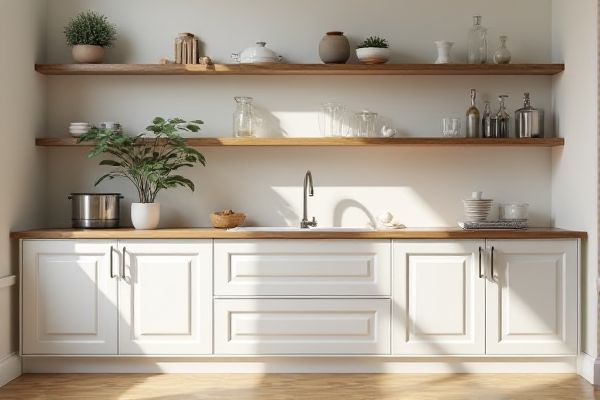
Floating shelves offer a sleek, modern look with open storage that maximizes space and accessibility, while traditional cabinets provide enclosed storage that protects items from dust and clutter. Explore the rest of the article to discover which option best suits your design preferences and functional needs.
Table of Comparison
| Feature | Floating Shelves | Traditional Cabinets |
|---|---|---|
| Design | Minimalist, open look | Classic, enclosed storage |
| Space Efficiency | Saves floor space, ideal for small rooms | Bulky, occupies floor space |
| Installation | Requires strong wall support | Requires floor and wall anchoring |
| Storage Capacity | Limited to visible, lightweight items | High capacity for diverse items |
| Maintenance | Easy to clean, dust-prone | Enclosed, less dust accumulation |
| Cost | Generally more affordable | Higher cost due to materials and construction |
| Usage | Best for decorative and frequently used items | Ideal for concealed, heavy storage |
Introduction to Floating Shelves and Traditional Cabinets
Floating shelves offer a minimalist and modern storage solution by mounting directly onto walls without visible supports, creating an open and airy aesthetic. Traditional cabinets provide enclosed storage with doors, countertops, and robust construction, ideal for keeping items hidden and protected in kitchens or living spaces. Both options balance functionality and style, with floating shelves emphasizing visual space and traditional cabinets prioritizing organized concealment.
Aesthetic Appeal: Modern vs Classic Looks
Floating shelves offer a sleek, modern aesthetic that enhances open spaces and creates a minimalist vibe, making them ideal for contemporary interiors. Traditional cabinets provide a classic, timeless look with solid structures and detailed craftsmanship that complement more formal or traditional decor styles. Your choice between these options will shape the overall visual impact of your room, balancing modern simplicity against classic elegance.
Space Utilization and Room Size Considerations
Floating shelves maximize space utilization by offering open storage that visually expands small rooms, making them ideal for compact areas. Traditional cabinets provide enclosed storage but can consume more floor space and create a bulkier appearance, which may overwhelm smaller rooms. Choosing floating shelves can enhance your room's openness while maintaining efficient storage in limited spaces.
Installation Process and Complexity
Floating shelves offer a straightforward installation process involving wall anchors and studs, typically requiring basic tools and minimal hardware. Traditional cabinets demand a more complex installation, often involving precise measurements, mounting to wall studs, securing to adjoining cabinetry, and potentially professional assistance. The simplicity of floating shelves makes them ideal for quick upgrades, while traditional cabinets require careful planning and skilled labor for stability and durability.
Storage Capacity and Organization
Floating shelves offer flexible storage solutions that maximize wall space, ideal for displaying items and keeping essentials accessible, but they typically provide less enclosed storage compared to traditional cabinets. Traditional cabinets excel in storage capacity and organization by offering multiple compartments with doors, protecting belongings from dust and clutter while allowing concealed and systematic arrangement. Your choice depends on whether you prioritize open display and easy access or secure, organized storage with ample capacity.
Maintenance and Cleaning Requirements
Floating shelves require less maintenance and are easier to clean due to their open design, allowing you to quickly wipe down surfaces without obstacles. Traditional cabinets often accumulate dust and grime inside enclosed spaces, necessitating more frequent interior cleaning and maintenance to prevent buildup. Your choice between the two should consider how much time and effort you want to spend on upkeep.
Cost Comparison and Budget Factors
Floating shelves generally cost less than traditional cabinets due to lower material and installation expenses, with prices averaging between $50 and $200 per linear foot compared to $150 to $500 for cabinets. Budget considerations should include not only upfront costs but also labor complexity, as floating shelves often allow for easier DIY installation, reducing overall project expenses. Long-term factors like durability and storage capacity also influence value, with cabinets offering more enclosed space but demanding higher maintenance investments.
Durability and Longevity
Floating shelves, crafted from high-quality materials like solid wood or metal, often offer robust durability and resist warping or sagging when properly installed. Traditional cabinets, built with thicker panels and reinforced joints, generally provide longer longevity under heavy use due to their enclosed design and sturdy construction. Your choice depends on the space's functional demands and the balance between aesthetic appeal and enduring strength.
Flexibility and Customization Options
Floating shelves offer greater flexibility with easy installation at varying heights and arrangements, allowing for tailored storage solutions that adapt to changing needs. Unlike traditional cabinets, which are often fixed and bulky, floating shelves enable more customization in design and layout, accommodating diverse spaces and styles. This adaptability helps maximize room efficiency while enhancing aesthetic appeal through personalized configurations.
Choosing the Right Option for Your Space
Floating shelves offer a sleek, modern aesthetic and save floor space, making them ideal for smaller rooms or minimalist designs. Traditional cabinets provide ample storage and concealment, suitable for organizing clutter and maintaining a tidy appearance in larger areas. Evaluate your space dimensions, storage needs, and design preferences to choose the best option that enhances functionality and style.
 homyna.com
homyna.com